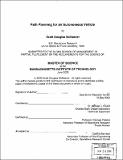| dc.contributor.advisor | Michael J. Ricard and Georgia Perakis. | en_US |
| dc.contributor.author | McKeever, Scott Douglas, 1976- | en_US |
| dc.contributor.other | Sloan School of Management. | en_US |
| dc.date.accessioned | 2005-08-23T14:55:58Z | |
| dc.date.available | 2005-08-23T14:55:58Z | |
| dc.date.copyright | 2000 | en_US |
| dc.date.issued | 2000 | en_US |
| dc.identifier.uri | http://hdl.handle.net/1721.1/8741 | |
| dc.description | Thesis (S.M.)--Massachusetts Institute of Technology, Sloan School of Management, 2000. | en_US |
| dc.description | Includes bibliographical references (p. 163-164). | en_US |
| dc.description.abstract | The desire for highly capable unmanned autonomous vehicles (UAVs), has necessitated the need for more research into the problems faced by these vehicles. One classic problem faced by UAVs concerns how the vehicle should traverse its environment in order to leave the current position and arrive at a desired location. The path to this goal location must maneuver the vehicle around any obstacles and reach the goal with minimal cost. A variant of this problem tasks the UAV with tracking a moving target. In this manner the UAVs trajectory is updated through time to reflect changes in the target's location. The specific mission addressed in this thesis, is the track and trail mission. This mission tasks a UAV with acquiring a target vehicle and tracking the vehicle for an indefinite period of time. The goal of this mission is not to intercept the vehicle, but to follow the target from a certain standoff distance. One can imagine many applications of this mission. One such application envisioned by the United States Navy deals with an unmanned underwater vehicle (UUV), tracking an enemy submarine. In addition, marine biologists could use such a capability to allow a UUV to follow and record valuable information on certain species. Planning these paths is conceptualized as a series of network shortest path problems. This thesis focuses on planning paths in the plane where the state of the vehicle is defined only by its position in space. In addition, a trajectory smoothing or path-smoothing component is addressed to eliminate any slope discontinuities as a result of the shortest path algorithms. A framework for the moving target shortest path problem is created. The resulting path planner is capable of performing the stated mission. A detailed simulation of the path planner operating on a UUV in an underwater environment is created in order to test the planner's performance. Different variants of the path planner are created in order to deal with different problem parameters. The resulting path planner is shown to be adaptable to these different conditions and effective at tracking a moving target. | en_US |
| dc.description.statementofresponsibility | by Scott Douglas McKeever. | en_US |
| dc.format.extent | 164 p. | en_US |
| dc.format.extent | 10923209 bytes | |
| dc.format.extent | 10922968 bytes | |
| dc.format.mimetype | application/pdf | |
| dc.format.mimetype | application/pdf | |
| dc.language.iso | eng | en_US |
| dc.publisher | Massachusetts Institute of Technology | en_US |
| dc.rights | M.I.T. theses are protected by copyright. They may be viewed from this source for any purpose, but reproduction or distribution in any format is prohibited without written permission. See provided URL for inquiries about permission. | en_US |
| dc.rights.uri | http://dspace.mit.edu/handle/1721.1/7582 | |
| dc.subject | Sloan School of Management. | en_US |
| dc.title | Path planning for an autonomous vehicle | en_US |
| dc.title.alternative | Path planning for a UAV | en_US |
| dc.type | Thesis | en_US |
| dc.description.degree | S.M. | en_US |
| dc.contributor.department | Sloan School of Management | |
| dc.identifier.oclc | 48040832 | en_US |
